New Update: Boost Social Proof with Reviews & Automation
New Update: Boost Social Proof with Reviews & Automation
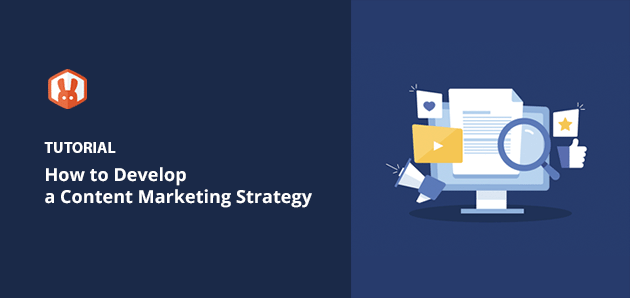
 John Turner
John Turner
 John Turner
John Turner
Do you want to know how to develop a content marketing strategy?
Without one, you risk your digital marketing efforts going to waste. By investing in a solid content marketing strategy you’re more likely to see success and excellent returns on your investment.
This in-depth article will show you how to develop a content marketing strategy step-by-step. Then you can grow your businesses without wasting time, money, and effort.
A content marketing strategy is a process of building an audience by creating and delivering content that turns site visitors into fans, leads, and customers. According to the Content Marketing Institute, 79% of B2B marketers said their organization used content marketing to further their goals.
Without a solid content marketing strategy, your marketing team’s efforts may seem like throwing spaghetti at the wall and seeing what sticks. That’s not a recipe for success.
A well-defined content marketing strategy brings structure and consistency to your efforts. It helps align your content with your business goals, ensuring every piece of content serves a purpose and moves you closer to your objectives. It also allows you to measure performance and adjust your approach based on data rather than guesswork.
Here are a few more reasons for building a content marketing plan:
Now that you know what a content marketing strategy is, let’s go ahead and learn how to develop one.
Here are the essential steps for developing a successful content marketing strategy:
To create a content strategy for your website, you need to flesh out your reasons for building a plan, what you want to include, and how you’ll carry out your content marketing efforts.
Learning how to develop a content marketing strategy might seem scary at first, but don’t worry. We’ll break each step down so you know how to reach your digital marketing goals.
Let’s dive in!

Writing a mission statement is an excellent start when developing a content marketing strategy.
Mission statements are short summaries of your aims and values as a company. And it helps you focus on which content formats are and are not essential so everything stays on track.
Here’s what a good mission statement covers:
For example, here’s the mission statement from Awesome Motive’s about page.

To create a mission statement for your business, give the following formula a try.
“We provide [audience] with [content] to help them [goals]”
Now, that covers what your audience gets from your content marketing strategy. But what about your business? What do you get from it? That’s where your business goals enter the picture.
Before you even start creating content, you need to define what you hope to achieve. Do you want to increase brand awareness, drive traffic, generate leads, or improve conversions? Each goal may require a different approach, so clear objectives are a must.
Here are a few ideas to help you out:
Now that you have your mission statement and business goals, it’s time to make them measurable.

The best way to achieve your goals is to make them easy to measure. And you can do that by setting some key performance indicators (KPIs).
KPIs are measurements that evaluate your success. Plus, they’ll let you know when you’ve achieved your goals with milestones you can tick off when you reach them. They include what you want to achieve with specific numbers attached to them.
Let’s look at some KPI examples, so you understand them better:
It’s also worth keeping an eye on your marketing costs too. Otherwise, your spending may get out of control with no returns to show for it. Here, you can learn how to measure your content marketing return on investment (ROI).
Now let’s move on to step 3, which is all about your audience.

A successful content marketing strategy hinges on understanding your audience. Who are they? What are their pain points? What content do they consume? Learning more about your audience can help you answer these questions and tailor your content accordingly.
There are 3 things to do to achieve this, which we cover below.
First, you must gather demographic data for your site visitors, email subscribers, and social media followers. Demographic data are statistics about who your visitors are.
For example, key demographics usually include the following information:
Web analytics software like Google Analytics is popular for site visitor data. And by digging deeper, you can see their key interests too.
You can find this information in Google Analytics by heading to Audience » Interests » Overview. From there, you can see the market segments your visitors fit into.
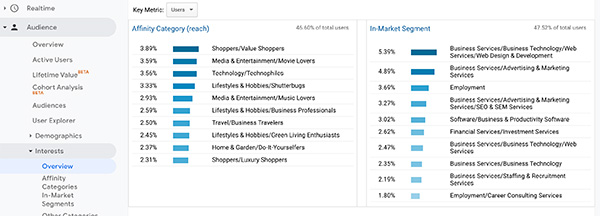
If you haven’t already done so, you can learn how to add Google Analytics to WordPress here.
Social media platforms offer similar analytics for audience insights. For Facebook, you can learn about your fans’ demographics by viewing your Facebook Page Insights.
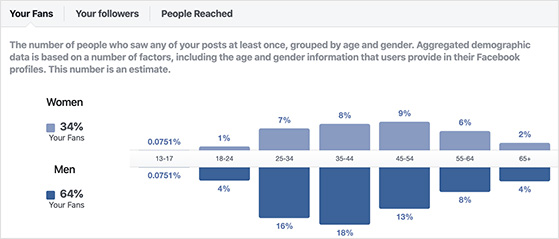
If your audience is on Twitter, you can view your followers’ demographics using Twitter Analytics.
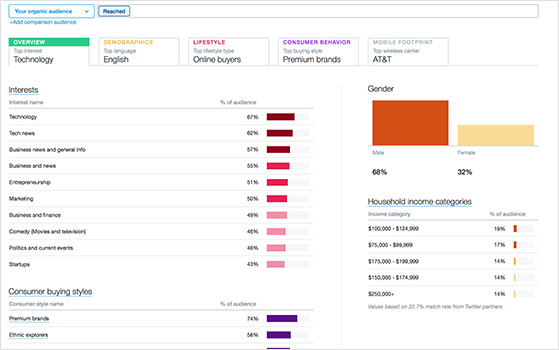
Now it’s time to learn more about your target audience. One way to do that is to collect feedback from your customers.
Doing so helps you figure out what their most pressing needs are and how they feel about your current content. It’ll also help you learn how to address their problems and if they’re happy with the buyer journey.
With the correct feedback, you can then do the following:
Here are several ways to collect customer feedback. And if you’re using surveys as one of your methods, you can learn how to get more survey responses in this step-by-step guide.

Once you have the demographics and customer feedback, you can build a buyer persona around that information.
Buyer personas define your ideal customers so you can target them better with the best content. Robust buyer personas include details on your customer’s pain points, information sources, and what motivates their behavior.
Once you know this, your content team will understand the right content visitors will respond to, how it’ll help them, and what makes them care about it.
This guide can teach you how to create a buyer persona.
When you’ve learned who your audience is and what motivates them, move on to the next step.
Chances are, you already have content on your blog or website. That content might be in the form of videos, social media content, or even podcasts.
Take stock of the content you already have. What’s working well? What’s falling flat?
A content audit does 3 things which are:
Let’s look at how to do this for your content marketing strategy.
An easy way to record your blog and site content is to use a content audit and research tool like the one offered by SEMRush.
You can do that by setting up a new project and choosing the part of your site you want to audit, like your blog. When you’ve chosen the URLs, click the Start Content Audit button.
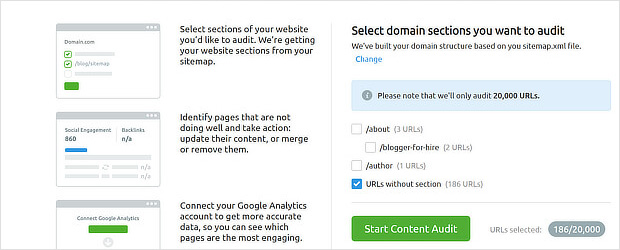
SEMRush then provides an overview of your content, including:
Then you can export that data to a spreadsheet with all the URLs.
With your content audit done, it’s time to see if it’s useful for your content marketing strategy.
Here are some of the key metrics to look for:
Much of that information is in the report above. But you can find more by using a few other SEMRush tools like the position tracking and site audit tools.

That info will let you know which content is working well and doesn’t need any changes and which ones need to be improved with further keyword research and optimization to meet your goals. It’ll also show you which content has no impact and needs removing from your content management plan.
The last part of this step is to find gaps in your content you can use them to reach your goals.
Those gaps might include:
Again, you can use SEMRush to discover gaps in your content. To do this, head to the Competitive Research Toolkit. Then under the SEO heading, click Keyword Gap.
From here, you can add your URL and the URLs of your competitors. Then click Compare.
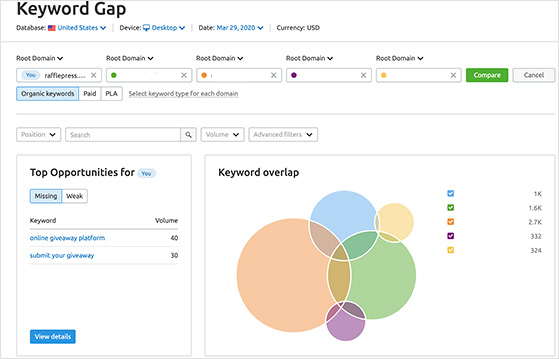
SEMRush will then reveal a list of competitor keywords you can target with your content.
You’re undoubtedly starting to get a good idea of where your ideal audience hangs out and where you’re having an impact.
But it’s worth making sure by looking at your analytics to see where your content is shared.
You can do this in Google Analytics by heading to Acquisition » Social » Overview.
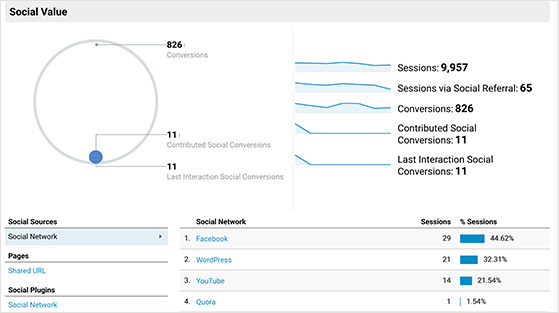
And Buzzsumo has a Content Analysis tool where you can see your shares by content type, network, content length, and more.
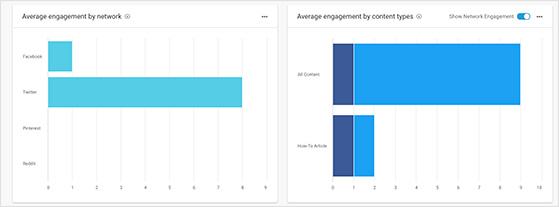
Once you have that information, you can figure out which networks to target for more engagement and social media shares for your content to improve lead generation.
Further Reading: 22 Online Apartment Marketing Ideas Guaranteed to Attract Renters
The next step is to determine the types of content you’d like to create.
When developing a content marketing strategy, the best approach is to have a core of content published on your website. Then you can repurpose that content and share it elsewhere online.
With this in mind, blog posts are a crucial part of your content mix. Your blog posts should be valuable and shareable with a good combination of article types.
How do you figure out which types of content to write?
Using the Buzzsumo tool we mentioned above, you can see the types of content your visitors already enjoy, matched with their total shares.
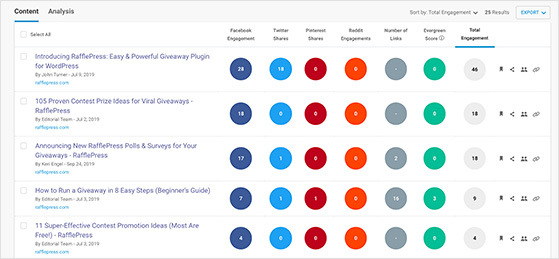
For instance, RafflePress readers love list articles and how-tos.
You can use the same tool to find other successful content, which you can use for inspiration.
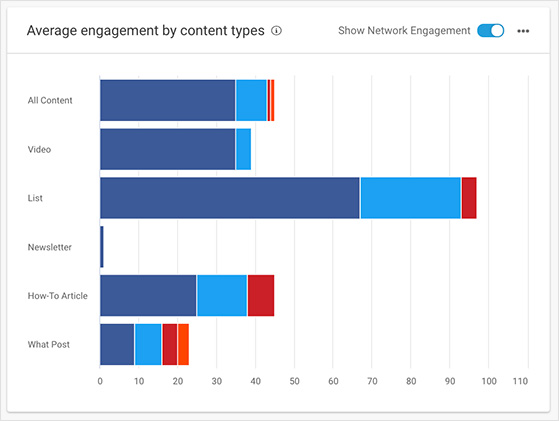
In this report, we can see that video content is a popular choice for our audience too.
It’s not just written content you’ll want to focus on either. Video content is a popular interactive content type that encourages engagement, keeps people on your site longer, and generates more leads.
Visual content also plays an essential part in your content mix. Images and infographics break up large walls of text and are excellent for sharing on visual platforms like Pinterest and Instagram.
Then there are advanced types of content such as lead magnets, ebooks, cheat sheets, white papers, webinars, case studies, and workbooks designed to boost leads and conversion rates.
Pro Tip: Different content types work for different businesses. What works for B2B marketers may not necessarily work for B2C companies. Dive into your data and look at competitors to see what works best for your audience.
When you’ve decided on what you’ll create, you need to work on a process for producing that content.

Next up, you must ensure you’ve got everything required to deliver your content marketing strategy.
Think of it as the 3 ‘Ws’ of your strategy, which we explain below:
Before we move on to creating any content, it’s worth building a content calendar, so you know what you’ll publish and when.
When you develop a content marketing strategy, it’s crucial knowing when you want to publish your content.
Building a content calendar prevents you from making mistakes through a lack of planning. And it’s pretty easy to create one.
One way to make a content calendar is to use a simple Google Calendar. Just add the due dates for each piece of content and go from there.
But if you have a large team with lots of content to manage, task management software like Asana is ideal for helping keep track. Even better, Asana comes with an Editorial Calendar Template, and you can customize it to fit the needs of your team.
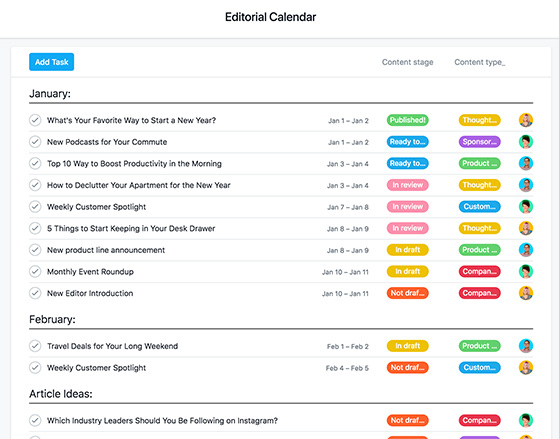
When you’ve fleshed out your content calendar, you can finally move on to creating content.
Now you’re ready to start creating your content. But if you haven’t done that before, doing it for the first time can be pretty scary. With that in mind, let’s consider how we’d approach writing a new blog post.
You’ve likely got a good idea of what to write about from your earlier research. In our example, our audience enjoyed list posts and how-to articles.
So the first step in our content creation process is to choose a title from the content calendar. Then you’ll need to research the topic.
You can do this by opening an incognito window in your browser and pasting the keywords for your text to find similar content.
Look carefully at the top search results and note what you can do to write something better.
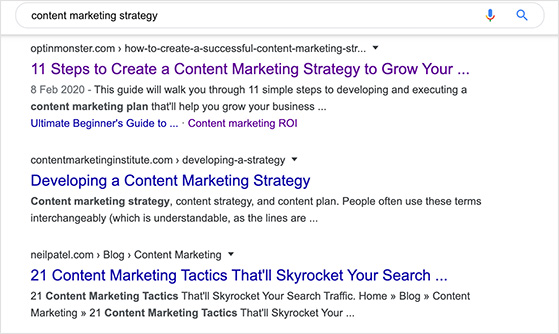
Then scroll to the bottom of the search page and note the Latent Semantic Indexing (LSI) terms. People might also use phrases to search for the content you’re researching. They’re also great for finding key talking points for your articles.
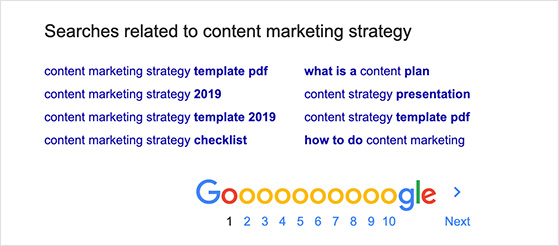
Next, put all your research together into a well-organized blog post. You might want to check out these SEO ranking factors so you can improve your chances of ranking in search engines.
But don’t forget to write for humans. Keep your writing clear, informative, and as if you’re chatting with a friend.

With your content written, the next step is to publish and market it to your audience. Without this step, you won’t reach many people and, in turn, won’t meet your goals.
Here are some ways you can market your content:
You can also use OptinMonster to promote your content on your site and through your newsletter. For example, LeadGuru used OptinMonster to convert 81% of visitors.
OptinMonster has many features to help you deliver lead magnets, direct new visitors to critical areas of your website, and engage them with new, timely content.
And with their powerful Exit-Intent® Technology, you can show targeting campaigns to people right when they’re leaving your site. Even better, it re-engages them, drives conversions, and reduces bounce rate, which is a key ranking signal.

Now the time has come to analyze and measure the results of your content marketing strategy. To do that, go back to the KPIs you set. Then see what’s changed and if you’re hitting your goals.
To recap, you can check the following places for performance analytics:
Monitoring your success makes it easier to adjust your strategy to stay up-to-date with changes in your audience’s behavior.
You should review your content marketing strategy regularly, at least once a quarter. This allows you to stay on top of industry trends, adjust to changes in your business, and pivot based on your performance data.
Content marketing is a long-term strategy. It can take several months to start seeing results, so patience is key.
The types of content you should include depend on your audience and objectives. Some content ideas include blog posts, videos, infographics, ebooks, and podcasts.
To make your content stand out, focus on providing value. Solve a problem, answer a question, or entertain your audience. Also, consider your unique selling proposition. What can you offer that no one else can?
The best way to promote your content depends on where your audience hangs out. Social media posts, email marketing, SEO, and guest blogging are all effective content promotion methods.
To measure your content performance, use metrics that align with your content marketing goals. Track these over time to determine if your strategy is effective.
And there you have it!
In this article, you’ve learned how to develop a content marketing strategy so you can tailor your content to reach your ideal audience. And as a result, get more traffic, leads, and paying customers.
To level up your marketing efforts, check out this guide on creating a retargeting strategy.
Don’t forget to follow us on YouTube, Twitter, and Facebook for more great tips to grow your business.
Disclosure: Our content is reader-supported. This means if you click on some of our links, then we may earn a commission. We only recommend products that we believe will add value to our readers.
Copyright © 2024 SeedProd LLC. RafflePress® is a registered trademark of SeedProd LLC